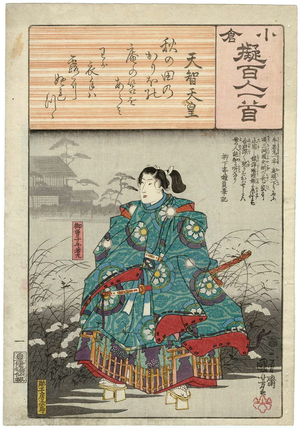Emperor Tenji
Lua error in Module:Unicode_data at line 293: attempt to index local 'data_module' (a boolean value)., also known as Emperor Tenchi, was the 38th Emperor of Japan,[1] according to the traditional order of succession.[2] His reign started in 661 and ended in 671.[3]
| Tenji | |
|---|---|
| Emperor of Japan | |
 | |
| 661–668 (regency) 668–672 | |
| Predecessor | Saimei |
| Successor | Kōbun |
| Born | 626 |
| Died | January 7, 672) Ōmi no Miya(Shiga) |
| Burial | Yamashina no misasagi (Kyoto) |
Traditional narrative
Before he became the monarch, his personal name (imina) was Lua error in Module:Unicode_data at line 293: attempt to index local 'data_module' (a boolean value)..[4]
He was the son of Emperor Jomei.
Events of Tenji's life
Prince Naka no Ōe was made heir apparent and Crown Prince in 661.
- 661: In the third year of Empress Saimei's reign, she died. Her son received the succession (senso), but he governed as Crown Prince for the next six years. He did not formally accept the monarch's role and duties and powers.[5]
- 668: Emperor Tenji became the monarch (sokui).[6] This was confirmed in ceremonies.[7]
- 668: In the seventh year of Tenji's reign, flammable water (petroleum) from Echigo Province was presented to Emperor Tenji.[8]
- 672: Tenji is said to have compiled the first Japanese legal code. This was the Ōmi Code, consisting of 22 volumes. These law became effective in the last year of Tenji's reign.[9]
Prince Ōtomo (Ōtomo-shinnō) was the favorite son of Emperor Tenji; and he was also the first to be accorded the title of Daijō-daijin.[10]
Tenji improved the military forces which had been established during the Taika reforms.[11]
After his death
The actual site of Tenji's grave is known.[1] This emperor is traditionally venerated at a memorial Shinto shrine (misasagi) at Yamashina-ku, Kyoto.
The Imperial Household Agency designates this location as Tenji's mausoleum. It is formally named Yamashina no misasagi.[12]
Emperor Tenji Media
Japanese Imperial kamon – a stylized chrysanthemum blossom
Related pages
References
- ↑ 1.0 1.1 Imperial Household Agency (Kunaichō): 天智天皇 (38)
- ↑ Ponsonby-Fane, Richard. (1959). The Imperial House of Japan, p. 52.
- ↑ Titsingh, Isaac. (1834). Annales des empereurs du Japon, pp. 52-58.
- ↑ Titsingh, pp. 52-53.
- ↑ Titsingh, pp. 52-54.
- ↑ Titsingh, p. 54.
- ↑ Varley, p. 44; a distinct act of senso is unrecognized prior to Emperor Tenji; and all sovereigns except Jitō, Yōzei, Go-Toba, and Fushimi have senso and sokui in the same year until the reign of Emperor Go-Murakami. Compare Imperial Household Agency (Kunaichō), Ceremony of Accession (Sokui-no-Rei); retrieved 2011-12-23.
- ↑ Aston, William George. (1896). Nihongi, p. 289 n2.
- ↑ Ponsonby-Fane, p. 52; Varley, p. 136 n. 43.
- ↑ Ponsonby-Fane, p. 53.
- ↑ Asakawa, Kan'ichi. (1903). The Early Institutional Life of Japan, p. 313.
- ↑ Ponsonby-Fane, p. 420.
Other websites
Media related to Emperor Tenji at Wikimedia Commons
| Preceded by Empress Saimei |
Emperor of Japan: Tenji 661–672 |
Succeeded by Emperor Kōbun |